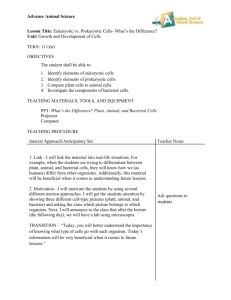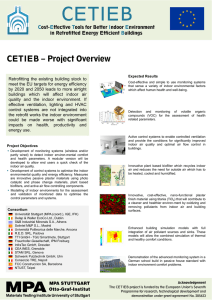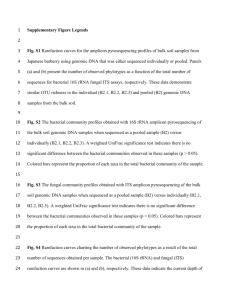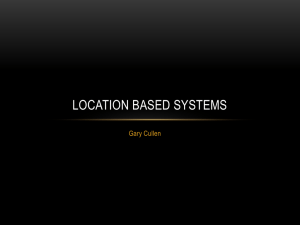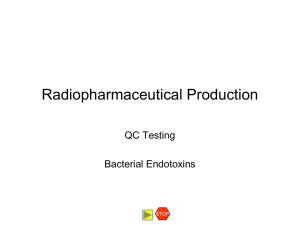news (2014.05.12)
advertisement
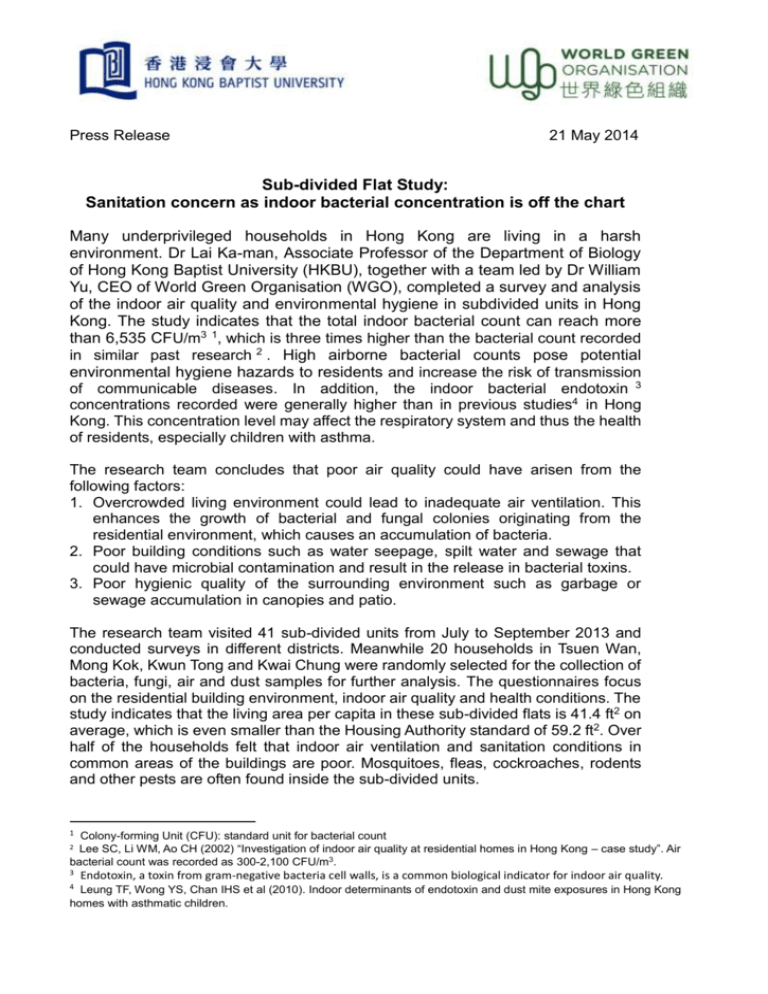
Press Release 21 May 2014 Sub-divided Flat Study: Sanitation concern as indoor bacterial concentration is off the chart Many underprivileged households in Hong Kong are living in a harsh environment. Dr Lai Ka-man, Associate Professor of the Department of Biology of Hong Kong Baptist University (HKBU), together with a team led by Dr William Yu, CEO of World Green Organisation (WGO), completed a survey and analysis of the indoor air quality and environmental hygiene in subdivided units in Hong Kong. The study indicates that the total indoor bacterial count can reach more than 6,535 CFU/m3 1, which is three times higher than the bacterial count recorded in similar past research 2 . High airborne bacterial counts pose potential environmental hygiene hazards to residents and increase the risk of transmission of communicable diseases. In addition, the indoor bacterial endotoxin 3 concentrations recorded were generally higher than in previous studies4 in Hong Kong. This concentration level may affect the respiratory system and thus the health of residents, especially children with asthma. The research team concludes that poor air quality could have arisen from the following factors: 1. Overcrowded living environment could lead to inadequate air ventilation. This enhances the growth of bacterial and fungal colonies originating from the residential environment, which causes an accumulation of bacteria. 2. Poor building conditions such as water seepage, spilt water and sewage that could have microbial contamination and result in the release in bacterial toxins. 3. Poor hygienic quality of the surrounding environment such as garbage or sewage accumulation in canopies and patio. The research team visited 41 sub-divided units from July to September 2013 and conducted surveys in different districts. Meanwhile 20 households in Tsuen Wan, Mong Kok, Kwun Tong and Kwai Chung were randomly selected for the collection of bacteria, fungi, air and dust samples for further analysis. The questionnaires focus on the residential building environment, indoor air quality and health conditions. The study indicates that the living area per capita in these sub-divided flats is 41.4 ft2 on average, which is even smaller than the Housing Authority standard of 59.2 ft2. Over half of the households felt that indoor air ventilation and sanitation conditions in common areas of the buildings are poor. Mosquitoes, fleas, cockroaches, rodents and other pests are often found inside the sub-divided units. 1 Colony-forming Unit (CFU): standard unit for bacterial count Lee SC, Li WM, Ao CH (2002) “Investigation of indoor air quality at residential homes in Hong Kong – case study”. Air bacterial count was recorded as 300-2,100 CFU/m3. 2 3 4 Endotoxin, a toxin from gram-negative bacteria cell walls, is a common biological indicator for indoor air quality. Leung TF, Wong YS, Chan IHS et al (2010). Indoor determinants of endotoxin and dust mite exposures in Hong Kong homes with asthmatic children. Seven out of the 20 studied sub-divided units did not meet the Air Quality Index5 in Hong Kong. The total bacterial counts in the sub-divided flats were measured as between 133 to 6,535 CFU/m3. The worst indoor air quality was recorded in sub-divided flats in Kwai Chung, Mong Kok and Tsuen Wan. The total bacterial counts in the cases of Mong Kok and Kwai Chung were even more than 6,535 CFU/m3 (reached the limit of measuring apparatus). This result is three times higher than in similar past studies2 which recorded bacterial counts of 2,100 CFU/m3. In the Kwai Chung case, three adults live in a poorly ventilated, crowded flat with lots of household items. Indoor carbon dioxide concentration and bacterial count are two important indicators of the indoor environment quality. Together with the analysis of other cases, it was found that there is a positive correlation between indoor carbon dioxide concentration and indoor bacterial count. The highest bacterial endotoxin content was recorded in the Mong Kok case (endotoxin concentration in ground dust was recorded as 96 EU/mg). This sub-divided flat is located in an aged building which will be demolished in the near future. Severe water seepage and sewage overflow was present in addition to lots of garbage accumulated near the building. This could result in microbial growth and release large amounts of bacterial endotoxin. The bacterial endotoxin amount in the Kwai Chung case is slightly lower than the Mong Kok case (endotoxin concentration in ground dust was recorded as 54 EU/mg). This household cleans the inside of the flat regularly, but lots of garbage was observed in the outdoor patio area. This shows that the outdoor hygiene condition could affect the indoor hygiene quality. This result matches with the significant positive correlation observed between indoor particulates with bacterial content and outdoor airborne environmental parameters. Dr Lai Ka-man of HKBU concludes that household cleaning is important to improve environmental quality but more urgently needs to be done to improve the building and outside environment. Landlords should take responsibility for providing tentants with basic environmental hygiene by conducting regular cleaning and maintenance of the building walls in order to avoid water seepage and subsequent microbial growth. Occupants of sub-divided units should avoid opening the windows directly facing rubbish sites, and hanging clothes and bedsheets in this area may bring dust into the living space and increase hazard exposure levels. Households should also take care of personal hygiene in order to minimise the transmission of communicable diseases. Next, the research team will study possible remedial measure to reduce environmental endotoxins and glucans, and the relationship between prolonged exposure to endotoxins and respiratory health of sub-divided unit households. Dr William Yu of WGO says that the sub-divided flat issue has increasingly aroused 5 There is no residential air quality standard in Hong Kon g. According to HKIAQ guidelines (IAQ Management Group, 2003), IAQ met “Good Class” if the indoor bacterial count is <1,000 CFU/m 3 concern in Hong Kong. He believes that the overcrowded environment not only increases fire safety concerns, but also causes poor air ventilation and thus is a potential health threat. On the positive correlation between carbon dioxide concentration and the indoor bacterial count, he speculates that because sub-divided flats have few or no windows, this affects the air circulation and causes carbon dioxide accumulation. Moisture accumulation, cooking and other activities would also induce the increase in bacterial content. WGO is now collecting different designs to improve the living environment of sub-divided flats. Dr Yu expresses his concern regarding the outdoor environmental hygiene affecting the indoor hygiene quality. Many tenants pay attention to indoor hygiene but overlook the condition outside. This study focuses on sub-divided flats located in the old areas of Hong Kong with buildings aged 30 years or older. Many of these buildings lack proper maintenance in the common areas and poor sanitation. The stairs are usually piled up with foul-smelling garbage. Dr Yu believes the Government should step up the promotion of regular cleaning and maintenance of these old buildings. This would improve the indoor air quality leading to an improvement in the quality of life of the residents living in sub-divided flats. Table 1: Cases studied that recorded high bacteria concentration in the air Parameter Total bacterial count in the air Range The total bacterial count per cubic meter is 133 to 6,535 units (CFU) Case 1 - >2,158 (Tsuen Wan) Case 2 - >2,614 (Tsuen Wan) Case 3 - >1,560 (Mong Kok) Case 4 - >6,535 (Mong Kok) Case 5 - >6,535 (Kwai Chung) Case 6 - 1,168 (Kwai Chung) Case 7 - 1,643 (Kwai Chung) For Media Enquiries: Dr. William Yu CEO, World Green Organisation Tel: 2391-1693 Email: williamyu@thewgo.org Vincent Law Communications Manager, World Green Organisation Tel: 2991-9105 Email: vincentlaw@thewgo.org Tina Ng Communication and Public Relations Office, Hong Kong Baptist University Tel:3411-5262 Email: hkbunews@hkbu.edu.hk

